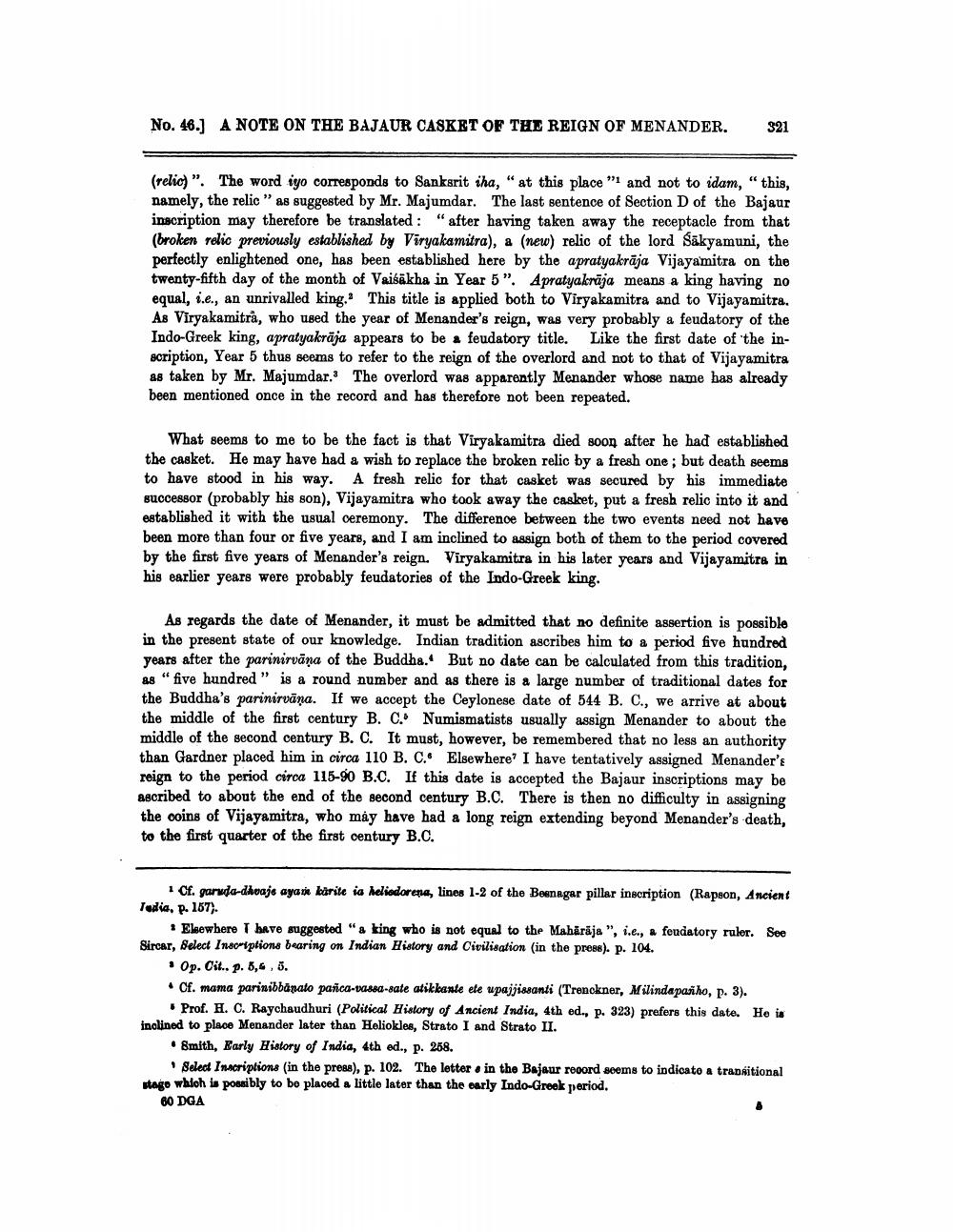________________
No. 46.) A NOTE ON THE BAJAUR CASKET OF THE REIGN OF MENANDER.
321
(relic)". The word iyo corresponds to Sankarit iha," at this place "'1 and not to idam," this, namely, the relic" as suggested by Mr. Majumdar. The last sentence of Section D of the Bajaur inscription may therefore be translated : "after having taken away the receptacle from that (broken relic previously established by Viryakamitra), a (new) relic of the lord sākyamuni, the perfectly enlightened one, has been established here by the apratyakrāja Vijayamitra on the twenty-fifth day of the month of Vaišākha in Year 5". Apratyakrāja means a king having no equal, i.e., an unrivalled king. This title is applied both to Viryakamitra and to Vijayamitra. As Viryakamitra, who used the year of Menander's reign, was very probably a feudatory of the Indo-Greek king, a pratyakräja appears to be a feudatory title. Like the first date of the inscription, Year 5 thus seems to refer to the reign of the overlord and not to that of Vijayamitra as taken by Mr. Majumdar.' The overlord was apparently Menander whose name has already been mentioned once in the record and has therefore not been repeated.
What seems to me to be the fact is that Viryakamitra died soon after he had established the casket. He may have had a wish to replace the broken relic by a fresh one; but death seems to have stood in his way. A fresh relic for that casket was secured by his immediate successor (probably his son), Vijayamitra who took away the casket, put a fresh relic into it and established it with the usual ceremony. The difference between the two events need not have been more than four or five years, and I am inclined to assign both of them to the period covered by the first five years of Menander's reign. Viryakamitra in his later years and Vijayamitra in his earlier years were probably feudatories of the Indo-Greek king.
As regards the date of Menander, it must be admitted that no definite assertion is possible in the present state of our knowledge. Indian tradition ascribes him to a period five hundred years after the parinirvana of the Buddha. But no date can be calculated from this tradition, A8 “five hundred " is a round number and as there is a large number of traditional dates for the Buddha's parinirvana. If we accept the Ceylonese date of 544 B. C., we arrive at about the middle of the first century B. C. Numismatists usually assign Menander to about the middle of the second century B. C. It must, however, be remembered that no less an authority than Gardner placed him in circa 110 B. C.• Elsewhere? I have tentatively assigned Menander's reign to the period circa 115-90 B.C. If this date is accepted the Bajaur inscriptions may be ascribed to about the end of the second century B.C. There is then no difficulty in assigning the coins of Vijayamitra, who máy have had a long reign extending beyond Menander's death, to the first quarter of the first century B.C.
Cf. garuda-dhwaje ayari barite ia heliodorena, lines 1-2 of the Beenagar pillar inscription (Rapson, Ancient Tedia, p. 157)
Elsewhere I have suggested "a king who is not equal to the Maharaja ", i.e., a foudatory ruler. See Sircar, Belect Inscriptions bearing on Indian History and Civilisation (in the press). p. 104.
• Op. cit., p. 3,4,5. . Cf. mama parinibbanato pañca-a88a-sate atikkante ete upajjiasanti (Trenckner, Milindapašiho, p. 3).
. Prof. H. C. Raychaudhuri (Political History of Ancient India, 4th ed., p. 323) prefers this date. He is inclined to place Menander later than Heliokles, Strato I and Strato II.
• Smith, Early History of India, 4th ed., p. 268.
Select Inscriptions in the press), p. 102. The lettere in the Bajaur rooord seems to indicato a transitional ago which la possibly to bo placed a little later than the early Indo-Greek period. 60 DGA




